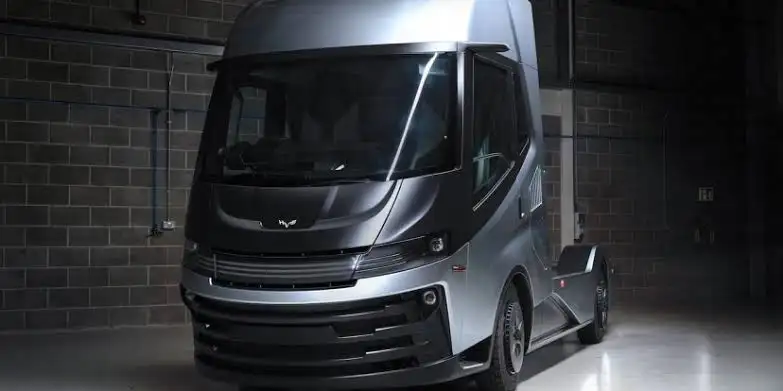
Courtesy of Hydrogen Vehicle Systems (HVS).
Scottish OEM, Hydrogen Vehicle Systems (HVS) has unveiled a new Hydrogen-Electric commercial vehicle which it claims emits zero greenhouse gases and will disrupt the truck manufacturing industry dominated by diesel power.
The firm has showcased its hydrogen-electric powertrain for the first time in the form of a 5.5 tonne demonstrator truck. HVS is planning to launch a 40-tonne zero-emission truck using its hydrogen-electric powertrain and is aiming to be the first in the UK to launch such a vehicle.
“This technology demonstrator showcases our ground-breaking hydrogen-electric commercial vehicle design and advanced powertrain technology, a precursor to our heavy goods vehicle (HGV) model. Fuelled by close-coupled green hydrogen (hydrogen produced directly by renewable energy sources such as hydro, wind or solar) our zero-emission trucks are a key part of decarbonising the logistics sector. Hydrogen is the perfect fuel for the haulage industry, offering longer ranges and quick refuelling thanks to stations easily integrated into key transport networks'” says HVS CEO, Jawad Khursheed.
HVS admits that the only emission from the vehicle is water vapour and goes on to claim that it means that there are no harmful greenhouse gas emissions of any kind.
Not caring about being politically correct, SA Trucker thinks the claims by HVS show either ignorance or lies that the water vapour emission is not harmful to the environment.
According to NASA, increased water vapour in the atmosphere amplifies the warming caused by other greenhouse gases. This means that water vapour is the crucial catalyst for the greenhouse gases to increase global warming – any increase thereof should be avoided.
NASA further explains, “As greenhouse gases like carbon dioxide and methane increase, Earth’s temperature rises in response. This increases evaporation from both water and land areas. Because warmer air holds more moisture, its concentration of water vapour increases. Specifically, this happens because water vapour does not condense and precipitate out of the atmosphere as easily at higher temperatures. The water vapour then absorbs heat radiated from Earth and prevents it from escaping out to space. This further warms the atmosphere, resulting in even more water vapour in the atmosphere. This is what scientists call a “positive feedback loop.” Scientists estimate this effect more than doubles the warming that would happen due to increasing carbon dioxide alone.
Read also: High battery prices delaying electric big trucks’ trip from shows to highways
Put in simple terms, increased water vapour in the atmosphere has more consequences than the effects of carbon dioxide on climate change.
Effects of increased water vapour on the atmosphere
An increase in atmospheric water vapour also intensifies the global water cycle resulting in extreme weather events. It contributes to making wet regions wetter and dry regions drier. The more water vapour that air contains, the more energy it holds. This energy fuels intense storms, particularly over land.
But more evaporation from the land also dries soils out. When water from intense storms falls on hard, dry ground, it runs off into rivers and streams instead of dampening soils. This increases the risk of drought.
In short, when atmospheric water vapour meets increased levels of other greenhouse gases, the impact on Earth’s climate is catastrophic.
This leaves us in a situation where scientists should weigh out the possible side effects of hydrogen fuel over diesel.
Hydrogen fuel may not overthrow diesel power after all, at least not anytime soon.






